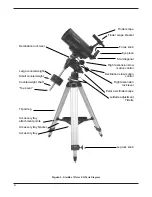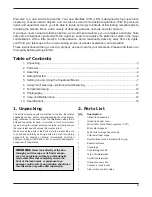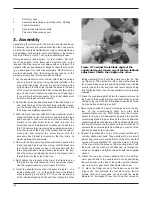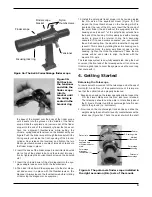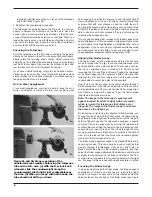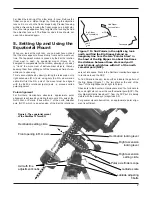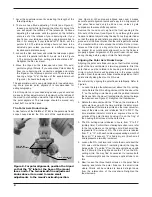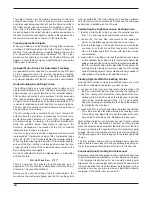
To star hop, only a minimal amount of additional equipment is
necessary. A star chart or atlas that shows stars to at least
magnitude 5 is required. Select one that shows the positions
of many deep-sky objects, so you will have a lot of options to
choose from. If you do not know the positions of the constella-
tions in the night sky, you will need a planisphere to identify
them.
Start by choosing bright objects to view. The brightness of an
object is measured by its visual magnitude; the brighter an
object, the lower its magnitude. Choose an object with a visu-
al magnitude of 9 or lower. Many beginners start with the
Messier objects, which represent some of the best and bright-
est deep-sky objects, first catalogued about 200 years ago by
the French astronomer Charles Messier.
Determine in which constellation the object lies. Now, find the
constellation in the sky. If you do not recognize the constella-
tions on sight, consult a planisphere. The planisphere gives
an all-sky view and shows which constellations are visible on
a given night at a given time.
Now, look at your star chart and find the brightest star in the
constellation that is near the object you are trying to find.
Using the finder scope, point the telescope at this star and
center it on the crosshairs. Next, look again at the star chart
and find another suitably bright star near the bright star cur-
rently centered in the finder. Keep in mind that the field of view
of the finder scope is about 6°, so you should choose another
star that is no more that 6° from the first star, if possible. Move
the telescope slightly, until the telescope is centered on the
new star.
Continue using stars as guideposts in this way until you are at
the approximate position of the object you are trying to find
(Figure 10). Look in the telescope’s eyepiece, and the object
should be somewhere within the field of view. If it’s not, sweep
the telescope carefully around the immediate vicinity until the
object is found.
If you have trouble finding the object, start the star hop again
from the brightest star near the object you wish to view. This
time, be sure the stars indicated on the star chart are in fact
the stars you are centering in the eyepiece.
7. Terrestrial Viewing
The StarMax 127mm not only excels at astronomical observ-
ing, it’s great for terrestrial (land) viewing too. The equatorial
mount, however, is not well suited for land viewing due to its
motion about R.A. and Dec. axes instead of altitude (vertical)
and azimuth (horizontal) axes. Because of this, we recom-
mend removing the optical tube from the EQ-3 Mount and
placing it on an appropriate photo-style tripod. To do this,
loosen the two optical tube attachment bolts with the supplied
wrench until the optical tube is freed from the mount. Make
sure to have a firm grip on the tube as it releases from the
mount. Now, connect the optical tube to a photo tripod by
threading the tripod’s 1/4"-20 shaft into the hole in the tube’s
mounting block.
The included mirror star diagonal, while preferred for astro-
nomical observing because of its viewing angle and better
resolution, is not optimal for land viewing because it inverts
images from left-to-right. We recommend purchasing an
optional 45° correct-image diagonal for terrestrial observing;
it provides a more comfortable viewing angle for land viewing
and an image that is oriented the same as the naked eye.
For terrestrial viewing, it’s best to stick with low power eye-
pieces that yield a magnification under 100x. At higher
powers, images rapidly lose sharpness and clarity due to
“heat waves” caused by Sun-heated air.
Remember to aim well clear of the Sun, unless the front of the
telescope is fitted with a professionally made solar filter and
the finder scope is covered with foil or some other completely
opaque material.
8. Photography
With an optional camera adapter, the StarMax 127mm
becomes a 1300mm f/12.7 telephoto lens for a single-lens
reflex camera. For long-distance terrestrial or astronomical
photography, you need only a T-ring for your specific camera
model. The T-ring attaches to your camera and threads onto
the StarMax’s eyepiece adapter (first remove eyepiece and
diagonal), coupling the camera body to the telescope.
Use the camera’s viewfinder to frame the picture. Use the
telescope’s focuser to focus the image.
You may want to consider using a remote shutter release
instead of the shutter release on the camera. Touching the
camera can vibrate the system and blur the resulting photo-
graphic image. Also, be sure to use a solid tripod.
9. Care and Maintenance
Transporting
The included soft carry case provides an excellent way to
transport the optical tube and its accessories. Loosen the two
optical tube attachment bolts with the supplied wrench until
the optical tube is freed from the mount. Make sure to have a
firm grip on the tube as it releases from the mount. To place
the optical tube in the case, the eyepiece, diagonal, finder
scope and bracket must be removed from the tube. When
removing the eyepiece and diagonal, remember to first
loosen the securing thumbscrews. The finder scope and
bracket can be removed together by loosening the thumb-
screw on the tube’s dovetail mount. Cover the front of the
optical tube with the dust cover and the rear opening of the
eyepiece adapter with its cap. Now place the tube in the
case’s main compartment underneath the padded divider.
The finder scope and bracket can be placed on top of the
divider as one unit. The eyepiece and diagonal should be cov-
ered with their caps and placed in the external compartments
of the case.
14


